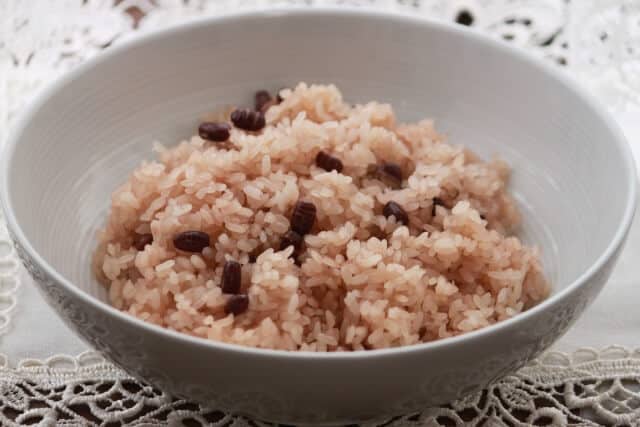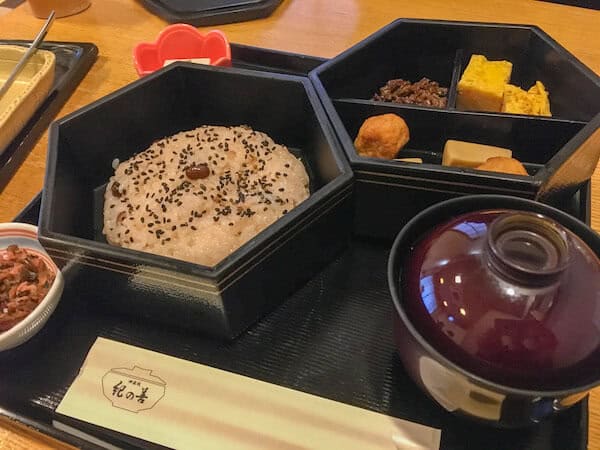Do you know about the origin of sekihan? Sekihan, which is indispensable for celebrations even until today, has a long history. At that time, it was considered a luxury food, and beans were believed to have special powers. However, how do Japanese eat Sekihan now? Today, in this article, we are going to introduce about Sekihan, its origin and history, recipes and let’s find out why this dish is so important to Japanese people.
What is Sekihan?
Sekihan is steamed rice mixed with glutinous rice and adzuki beans or cowpeas and is a traditional dish mainly the Japanese eat on celebratory occasions in Japan. The colour of adzuki beans and cowpeas transferred to the boiling liquid and absorbed by the glutinous rice, resulting in a reddish colour. In addition, locals use this as a meal on special occasions, they sometimes use this for good luck, but in some areas, they use it as bad luck. Canned and freeze-dried products are also popular due to their high nutritional value and as emergency food.
Sekihan History

Sekihan has its roots in the middle of the Heian period, and they wrote the original form of sekihan as red bean porridge in the “Makura no Soshi” (The Pillow Book). They use this for celebratory occasions in the Muromachi period. And in the latter half of the Edo period, it spread to the dining table of ordinary people on special occasions.
In the “Chujiruiki,” which describes the menus of the Imperial Court in the late Kamakura period, locals ate this at seasonal milestones such as Joshi no Sekku on March 3, Tango no Sekku on May 5, and Choyo no Sekku on September 9. There is a record that it is an event meal. After it became available in the private sector, it seems that the Japanese ate this at familiar celebratory events. Depending on the region, it seems that there are places where they ate red rice at Buddhist ceremonies to repay bad luck and restore good luck.
Sekihan Recipe

Sekihan Ingredients
| Ingredients of Sekihan for 4-5 people | Measurements |
|---|---|
| Sticky rice | 540g |
| Azuki | 43g |
| Water | 400g |
| Sugar | 7g |
| Salt | 20g |
| Sesame or sesame salt | 3g |
How to make Sekihan
Strain the glutinous rice into a colander. Boiled the glutinous rice for at least 3 hours, so count backwards and wash. The night before, or half a day before, you can sieve it and put it in a colander.
Wash the adzuki beans, add 5 times the amount of water to the adzuki beans and heat.
Boil until soft. If the heat is too high, the belly of the adzuki bean will crack, and it will look bad and bring bad luck, so be careful when boiling.
Divide into broth and adzuki beans. Then, put the rice in a thick pot, add water to the broth to make 400cc, and soak for about 2 hours.
Add the sugar and salt and bring to a boil. When the rice comes to a boil, use a wooden spatula to gently mix the rice. Then, place a steaming cloth dampened with water on the top of the steamer. Put adzuki beans on top, and cover with a cloth. Place them in the lower pan with boiling water, cover with a lid, and steam over high heat for 30 to 35 minutes
After 30 minutes, pinch and eat. If it feels a little hard, steam it for a few more minutes. After steaming, transfer to a bowl while stirring gently and sprinkle with sesame seeds.
Why do the Japanese eat sekihan on important days and celebrations?

The health benefits of sekihan, which uses adzuki beans, are well-known even today, but why is sekihan so indispensable for celebratory days and celebrations? The reason for this is the red colour of adzuki beans. Red foods have the power to ward off evil and ward off evil in Japan. From such circumstances, they served it at celebrations.
The main events related to sekihan include baby showers, first festivals, first eating, shichigosan, and other events to celebrate the growth of children. In addition, it is an indispensable dish for 60th birthday celebrations, 70th birthday celebrations, and Kishou celebrations. Many families will prepare sekihan for the Shichi-Go-San Festival, which is about to reach its peak. Adzuki beans are not only good fortune but also contain many nutritional components such as polyphenols.
Nutritional benefits of Sekihan

Anemia prevention
Adzuki beans and cowpeas are rich in iron, which is the main component of hemoglobin in red blood cells and is essential for making blood. Therefore, it is effective in preventing anemia.
Rich in protein
Red rice contains a lot of beans, so it is also rich in protein. Protein is an important nutrient that forms the basis of the cells that make up the body, such as muscles and organs, and produces hormones and enzymes.
Fatigue recovery
Red beans and cowpeas are also known to be rich in B vitamins. The amount is the same as brown rice. It is an excellent nutrient that efficiently uses energy in the body and reduces fatigue substances.
Relieve constipation
Adzuki beans and cowpeas are rich in dietary fiber, and can improve the intestinal environment (regulating the intestines) and relieve constipation. When constipation is eliminated, it is thought that the waste and toxins accumulated in the body can be easily discharged, making it easier to lose weight. It is also important to drink plenty of water to increase constipation relief. Drink plenty of water after eating sekihan.
What goes well with Sekihan?

Sekihan is a dish meant for celebrations because of its red colour and the presence of azuki beans. Locals eat it at any time though and they usually served this at room temperature. Sekihan is usually paired with a sprinkling of gomashio, a Japanese flavouring which is sesame seed mixed with salt. Because the glutinous rice matches perfectly with the flavour of the adzuki beans and the salty taste.
Where to buy Sekihan
Kinozen (ç´€ã®å–„)

Kinozen is a sweets shop in Kagurazakashita, Tokyo. In addition to Anmitsu, Shiruko, and Matcha Bavarois, they offer seasonal menus such as strawberry anmitsu in spring, shaved ice, shiratama zenzai and chilled shijiruko in summer, and chestnut anmitsu, millet zenzai and kuzumochi in fall and winter. They also have rice dishes such as kamameshi, sekihan bento, and duck porridge (autumn/winter).
Shimura (目白 志むら)

The red rice or sekihan has a traditional natural colour, and the black sesame roasted with salt, which they served separately, matches the red rice well and brings out the umami, unlike the miscellaneous ordinary shops. The store serves a glittering or voluminous amount of it and sometimes it’s refreshing, and it is good to have it on seasonal days.
Nichigetsudo (æ—¥æœˆå ‚)

The rice used for our sekihan is all domestically produced. It seems that various manufacturing methods are depending on the region, but they make the colour of their sekihan using only the broth extracted when they cooked the high-quality [coconut beans]. The colour and fragrance are finished to the best quality. At their shop, they have a long-standing relationship of trust with a glutinous rice specialist, and they select the best quality local rice of the year.
Final Thoughts

Japanese people typically prepare sticky rice (Mochigome) cooked with Azuki red beans, known as Sekihan, to celebrate something. According to legend, red rice was traditionally offered to gods in ancient Japan, and they gave cooked rice out to the public. In recent years, sekihan has gained popularity as a healthier alternative to traditional white rice.
There are other rice bowl dishes such as some of the different gohan like Tamago Kake Gohan and donburi type like Gyudon.
















Comments